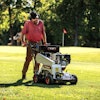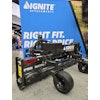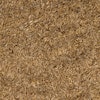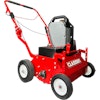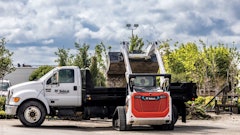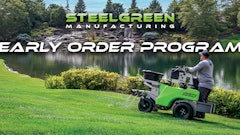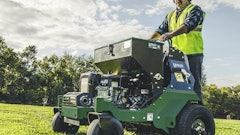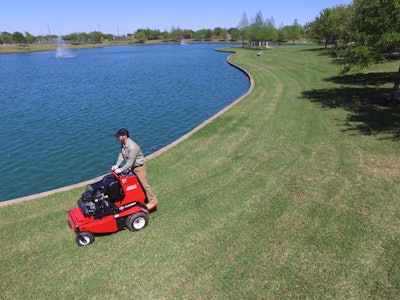
Much like the stand-on mower, stand-on aerators have been around a while. For many years they remained somewhat of a novelty. Their popularity has grown, though, as productivity-minded contractors have come to recognize the benefits of standing up while operating riding equipment.
"Toro has offered its 30-inch stand-on aerator for approximately five years, which has consistently been a popular product for landscape contractors," says Chris Hannan, senior marketing manager at Toro. "Although both stand-on and walk-behind aerator configurations are important to Toro’s complete aerator offering, we have found that recently many contractors are considering stand-on aerators due to the gains in productivity.”
The stand-on aerator actually goes back further than five years. Classen, a Schiller Grounds Care brand, introduced its first stand-on in 2004, the SA25 Stand-Aer. The company has now introduced a brand new model this spring, the Classen Pro SA30 Stand-Aer.
"The size of the market is growing rapidly," says Linda Beattie, Classen marketing manager. "Until a couple of years ago, the market for a stand-on was rather niche. Customers were golf course and sports turf superintendents, municipalities, and dedicated turf care professionals with large properties."
Nowadays, more landscape contractors are starting to see the benefits of having a stand-on aerator on typically sized properties.
"Recent innovations have allowed these units to gain traction and popularity," says Matt Donohue, Ryan brand director, another Schiller Grounds Care brand. "I would estimate that there are 8,000 to 10,000 machines in use today, with likely annual unit sales of 2,000 to 3,000 per year—growing significantly in recent years." Ryan recently introduced a new stand-on aerator, the Lawnaire ZTS.
In addition to Ryan, Classen and Toro, other manufacturers offering stand-on aerators include Exmark and LT Rich. Turfco offers an aerator with a tow-behind standing platform that also allows operators to stand and ride while aerating.
How contractors benefit
According to Donohue, stand-on aerators provide three main benefits that you cannot get with a walk-behind: efficiency and speed, operator comfort and reduced fatigue, and consistent tine penetration—even in hard, compacted soil.
Simply put, a stand-on aerator can help improve productivity for landscapers. "A stand-on is faster in both transport and operation, covering far more ground in less time," Beattie says. For example, Classen's original SA25 featured split-drive technology that allowed the unit to zero-turn in transport mode and maintain a tight 24-inch turning radius when in use. This made the machine more productive than a walk-behind due to the wider aeration swath and faster 4.7-mph operating speed.
"Today's units are designed more like stand-on mowers with operational speeds up to 7 mph," Beattie points out. It took a while for the product to evolve as necessary, she says, primarily due to stand-on mower design patents that expired just a couple of years ago. "Today's stand-ons are also more comfortable and easier to maneuver," Beattie adds.
Maneuverability is an important point. "Historically, aeration is a gut-busting task that most operators dread, due to the jarring nature and physical demands of a traditional walk-behind," Donohue explains. "It's common for operators to fight over who gets to use the stand-on for particular jobs. Most have comfortable rider platforms with some kind of suspension system. And of course, it's always a lot more fun to ride a machine than walk."
What contractors want
Beattie says Classen performed extensive voice-of-customer research throughout the SA30 Stand-Aer development process. They found that operators had been making sacrifices in the areas of core quality, operator comfort and ease of maintenance.
Likewise, Donohue says Ryan's research led it to develop a machine that would greatly reduce maintenance and upkeep, enhance usability through more ergonomic controls, and perform better in challenging soil conditions due to a unique tine system/drive system design.
"Most stand-on aerators have hydraulic down-pressure systems that, along with the weight of the machine and operator, provide additional downforce needed to get the tines into even the most hard and dry soil," Donohue explains. "In many areas of the country, walk-behind aerators simply cannot penetrate the soil when it is dry and compacted."
The new Classen SA30 features a hydraulically driven rapid tine engagement system that reportedly lifts and lowers the tines 27% faster than competitive models. This reduces the risk of turf tearing when turning during operation. The SA30 also utilizes a thicker tine shaft with dual tine arms that apply equal leveled pressure, helping to ensure leveled core depth while reducing wear and tear on both the tines and shaft.
"Quality of core was a primary focus for us," Beattie says. The SA30 has a 48-tine assembly that produces a tighter hole pattern. Additionally, the operator can set a maximum tine depth in any of seven half-inch increments from 2-5 inches for precise, consistent cores.
When you're talking about quality aeration, you can't ignore ease of use and operator comfort. "With one of the main reasons to own a stand-on aerator being efficiency, the controls must be easy to operate and get to without compromising speed or efficiency," Donohue says.
Classen has focused on making tine engagement easier through a simple thumb switch on the hand controls, as opposed to a button or foot pedal found on some other machines. "Moving the tine engagement to the hand control area also allowed for the development of a superior rider platform," Beattie adds.
Reliability is one more consideration that is always important to a professional user. "Air temperatures as low as 80° F can contribute to increased hydraulic oil temperatures, causing transaxles to overheat," Beattie explains. "Waiting for transaxles to cool down takes time out of the day for busy professionals. Our SA30 features an exclusive Hydra-Cool hydraulic oil-cooling system, enabling the engine to power a cooling circuit in the oil tank that keeps oil temperatures low in extreme conditions."
Staying on the topic of reliability, Beattie says the top issue identified through Classen's research was drive-chain slippage, also known as chain popping. It can be caused by dirt or debris building up on the exposed chains, forcing the chain to slip off of the sprocket. Getting the chain back on can be a time-consuming chore. Additionally, having to manually check and adjust chain tension can be a pain in and of itself.
"Our solution was to take manual drive-chain tensioning out the equation through the development of an automatic chain-tensioning system," Beattie says. "We also shield the chain from the elements and designed the entire unit with tool-free, easy-access panels to all common maintenance areas including the chains, battery, tines, fluid tanks and lines. We even created a tool-free rear jack system that lifts the rear of the unit off the ground, making drive tire replacement as well as tine clean-up and maintenance easier."
Maintenance needs and serviceability are indeed important considerations. "Some brands require maintenance adjustments every 5-10 hours of use, and most only offer a one-year warranty," Donohue says. "Ryan has much longer maintenance intervals and offers a standard two-year warranty."
That's great if you're looking to own a stand-on aerator. But owning isn't your only option. "The latest trend is for contractors to rent one—even for weeks at a time," Donohue says. "We are definitely seeing a trend toward more rental house availability."

